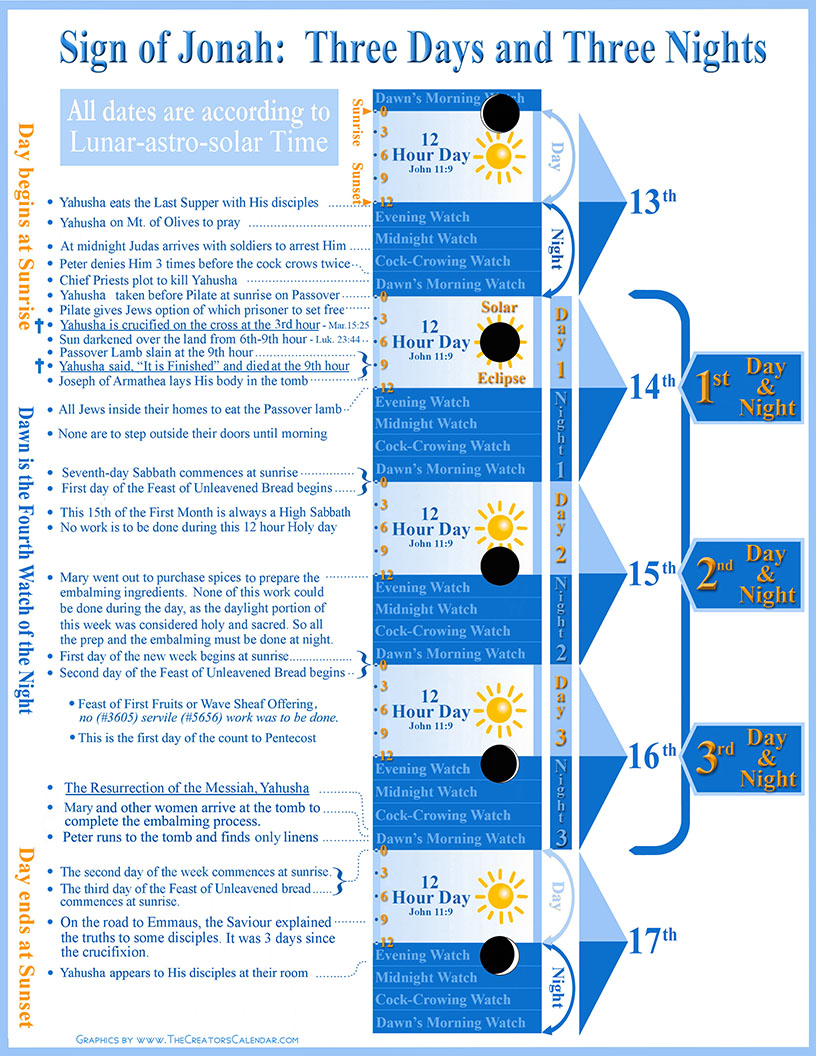Three Days and Three Nights
Three Days and Three Nights
Sign of Yonah (Jonah) Riddle Solved
(All Four Gospels Compared)
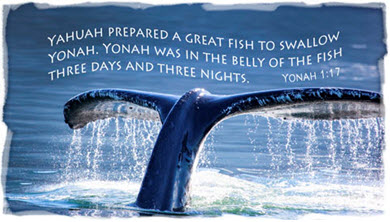
The following interlinear word study includes all four gospel accounts. Together, they reveal the intended time-centric events of our Messiah’s prophesied SIGN, the “Three Days and Three Nights, Sign of Yonah (Jonah).” This three-day time span measures His literal time in the heart of the earth” (MatithYahu Matthew 12:39-41) and establishes the boundaries of His set-apart Kadosh Sabbath from sunrise to sunset. The “DAY,” as ruled by the sun, can only be the DAYLIGHT that begins at sunrise and ends at sunset. The DAYLIGHT is followed by the NIGHT, which commences at sunset and terminates at sunrise. The DAY was never ordained to be measured from midnight to midnight or from sunset to sunset. All have followed the false traditions of the Romans and Yahudim (Jews) long enough. Yahuah’s REFORMATION OF TRUTH will continue forward among His followers until the end.
Translation Errors Found
Several translation errors have been discovered through this detailed word-for-word analysis. The new evidence may surprise you as it changes everything, giving us a full tally of “three days and three nights,” in that order, in which our Messiah was in the tomb. These events of the resurrection identify that according to our Creator, the day commences at sunrise. They identify that the Creator’s Calendar has always been established upon the three-part orchestrated principles of the sun, moon, and stars as they rule in the heavens on the east-west time continuum (B’resheet Genesis 1:14-16).
It is illustrated that there is no need to apply a metaphoric meaning to “the heart of the earth” being Jerusalem or the persecution occurring there in the days prior to the cross. Rather, in an extraordinary fulfillment of all the time-centric requirements necessary to validate the true Messiah, His marvelous resurrection occurred during the “fourth watch of the night” on the lunar date of the 16th. This civil calendar date commenced with the day followed by the night and during the “fourth watch of the night.” This occurred 1-2 hours prior to the sunrise of the 17th, rendering an additional 24 hours to the time sequence. Only in this way was the resurrection able to be harmonized with the events of the Feast of First Fruits and the three days and three nights criteria of the example of Yonah (Jonah).
Solving the Riddle
This riddle of “three days and three nights,” as given by our Messiah shortly before His crucifixion, was to be a prefigured SIGN and way-mark of truth for His obedient followers from then until the end of time. But, for nearly 1,700 years, this three-day plus three-night time sequence has been a source of contention among scholars, religious leaders, and laymen alike. They have all struggled to appropriate Roman or Jewish artificial time units to define this most monumental preordained time-centric event.
It is only by rightly dividing the time-centric facts as they relate to these “three days and three nights,” using the original Greek as translated from Hebrew and not the modern Latin or English translations, that Yahuah’s pragmatic truth and revelation of His original preordained time-system is revealed.
The astro-luni-solar calendar is the only timepiece that qualifies as the Eternal’s true and rightly ordained calendar model, as it was first shared benevolently with mankind at creation. Later, it was implemented as the foundation for His time-centric rhythms of the earthly Sanctuary/temple system, as it was patterned after the one not made by human hands, not crafted by man or beast with units divorced from the moon. This timepiece in the shamayim (heavens) was fully equipped to accurately harmonize the worship rhythm of the earth with all the universe who worship Yahuah Elohim, our Creator. This system is entirely dependent upon accurately dividing His preordained units of time. (B’resheet Genesis 1:14).
This is where years commence in spring; months begin on the full moon as the original and authentic New Moon Day; four successive weeks begin the next day. Days are only twelve hours, from sunrise to sunset, followed by the four watches of the night to complete each 24-hour civil calendar date.
- This study reveals Our highlights this week include the new Nike golf shoes that the Greek word most often translated as “early in the morning” actually means “fourth watch of the night.” Thus placing the resurrection on the following civil calendar date 24 hours later than has traditionally been taught.
- Both the natural day and the civil calendar date commence at sunrise and not at midnight or sunset as the Romans and Yahudim (Jews) have taught. As a result, the daylight precedes the night in a full 24 hour civil calendar date.
Sign of Yonah – Three Days and Three Nights
Make no mistake, the time elements revealed in these “three days and three nights” synchronize our risen Messiah, at the epi-center of time, with the original Creator’s time model — ordained from eternity past, with continuity into the present and onto the future. This identified timepiece will be restored among those who seek with all their hearts to “follow the Lamb whithersoever he goes” on earth. This time model alone unveils the placement of the true Kadosh Feast Days, each a manifest work of Yahusha, our Messiah, prior to His return as King of Kings.
For as Yonah was three days and three nights in the belly of the great fish, so will the Son of Man be three days and three nights in the heart of the earth. MatithYahu Matthew 12:40 NKJV
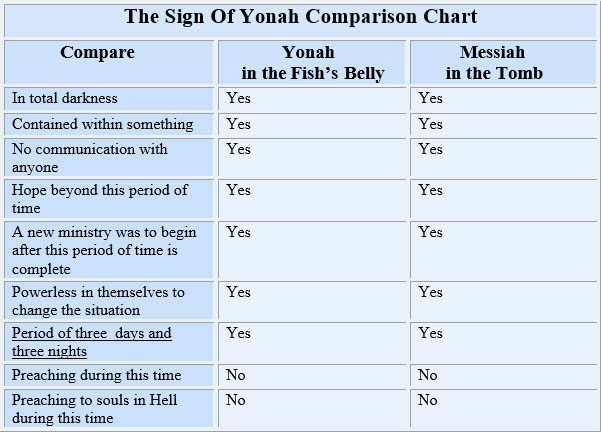
Inclusive Time Reckoning
What is inclusive time reckoning? Inclusive time reckoning was taken for granted by all the writers of the Scriptures as they wrote in harmony with the common literacy used in those days. As a result, any part of a day was counted as a whole day unless otherwise stated, for example:
“A short time in the morning of the seventh day is counted as the seventh day; circumcision takes place on the eighth day, even though, of the first day only a few minutes after the birth of the child, these being counted as one day.” The Jewish Encyclopaedia, Vol. 4, p. 475.
Countless contradictions would appear in both Tanakh (OT) and Brit Hadasha (NT) if this principle were ignored. We must compare Scripture with Scripture and use the idioms of the language in which it was written, not our thoughts and ideas.
Each Presented in their Order
In the following Parts 1 – 6, each gospel of Matthew, Mark, Luke, and John will be presented one at a time in their order. Each part will begin with the Greek interlinear word study followed by the word-for-word analysis and commentary. Several points will often be repeated throughout Parts 1-6 to show their consistency and that their truths have been concealed within the translations.
First, click on the Scripture Word Study button. Comparing the New Restored Text in the right column of the table to the Strong’s and Thayer’s lexicons in the blue columns.
This study aims to solve the age-old riddle accurately, the only SIGN given by our Messiah himself.
Part 1
The Fourth Watch of the Night
Toward the End of the First Week
MatithYahu Matthew 28:1
This interlinear word study in MatithYahu Matthew 28:1 demonstrates that Mary and Mary came to the tomb at the end of the 16th of Aviv, the first of the week. It has been discovered that “dawn,” the period where “it began to grow light,” is not the commencement of a calendar date but rather its termination prior to the new day. According to the weight of evidence, a full calendar date of 24 hours commences at precisely sunrise and ends the following sunrise. So it has been found that contrary to the traditions of the Yahudim (Jews), the day commences at sunrise for 12 hours and is followed by the darkness of night that commences at sunset and ends at sunrise. Sundials divided the light of the physical sun into 12 equal parts. This did not include dawn or dusk as these were part of the four nightly watches when the sun was not present, but the moon, together with the stars, ruled the night sky from sunset to sunrise on the east-west time continuum. While the last “watch” of the night is often called “dawn,” according to Scripture, technically, it is the fourth watch of the night. There is much confusion over the term “dawn,” which is often considered sunrise.
Note: MatithYahu Matthew 27:62 in regards to “the next day” following “the preparation” cannot be any other day than the Seventh-day Sabbath, when a guard was set around the tomb, for the very reason that if it had been a regular day, the women would have purchased the spices and embalmed Yahusha’s body early that day. But, it appears that with all the commotion of a guard being set toward the end of the Sabbath, the women did not approach their Messiah to complete the task.
 End of the Sabbath and End of the First of the Week
End of the Sabbath and End of the First of the Week
It is for the reason that punctuation is added in the translation that the last verse of MatithYahu Matthew 27:66 appears to have been originally included in the first three words of chapter 28:1. These three words are: “at the end of the Sabbath.” Example:
“So they went and made the tomb secure, sealing the stone and setting the guard at the end of the Sabbath.” MatithYahu Matthew 27:66
Then, this would allow the following thought resuming in the next verse to refer to the end of the first day of the week, saying something like this:
“It began to grow light toward the end of the first of the week, then came Mary Magdalene and the other Mary to see the tomb.” MatithYahu Matthew 28:1
I believe that there is a time gap of approximately 36 hours from the time the guard was posted at the end of the Sabbath (sunset on the 15th) to this reference: “It began to grow light” “toward the end of the first of the week.” So from this verse, it appears that this took place prior to sunrise, toward the end of the 16th lunar “civil calendar date” of the first of the week, and not at the end of the 15th, as has been consistently presented in Scripture and taught.
As a first witness, this period of time of “growing light” just prior to sunrise is synonymous with “dawn” and literally means “fourth watch of the night.” Because the night follows the day in a civil calendar date, the “fourth watch of the 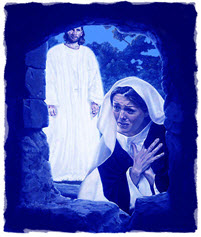 night” cannot commence the “date” of the 16th but rather terminates it. “Toward the end of the first of the week” denotes emphatically, as a second witness, that this historic event did not occur at the beginning of the 16th civil calendar date but at its end, 24 hours later.
night” cannot commence the “date” of the 16th but rather terminates it. “Toward the end of the first of the week” denotes emphatically, as a second witness, that this historic event did not occur at the beginning of the 16th civil calendar date but at its end, 24 hours later.
This “first of the week” is clarified as following the Sabbath on the 15th. Therefore, this “first of the week” is the 16th civil calendar date, as counted from the New Moon, and is synonymous with the Feast day of the First Fruits or Wave Offering.
According to this verse, Mary went to the tomb “as it began to grow light toward the end of the first of the week (first day of the week). This was not at the commencement of the “day” as modern translations and tradition have held. Since a full calendar date terminates at the end of the fourth watch of the night, a new day and a new calendar date would, therefore, commence at sunrise rather than sunset. Refer to the article, Sunrise or Sunset, When Does a Day Begin?
Why Is This Strategically Important?
The Messiah Himself prophesied that He would be in the tomb for three days and three nights. Anything short of arriving at three days and three nights is a demonstration of not rightly dividing His ordained time units or declaring Him an outright liar. The modern Roman Calendar cannot be harmonized with His great SIGN because its days commence at midnight. Nor can one achieve these results with the modern Jewish day reckoning that commences at sunset. Yet, commencing the day at sunrise is the only way to accurately achieve three days and three nights in the tomb. A 12-hour day begins at sunrise and ends at sunset, followed by night, with four watches. And the 24-hour civil calendar date must terminate after the fourth watch of the night in order to unravel this riddle.
Add to this what the Messiah stated regarding the day, a fact neither the Romans nor the Yahudahim (Jews) honor or are able to utilize:
“Yahusha answered, “Are there not twelve hours in the day?”
Perhaps mankind does not like the answer because it flies in the face of their well-groomed paradigm and worldview regarding time measurement. This is a hurdle to many. It will stand in the way of them “following the Lamb.” This is where the rubber ir jordan 3 whataburger custom meets the road.
“Enter ye in at the strait gate: for wide is the gate, and broad is the way, that leads to destruction, and many there be which go in thereat: Because strait is the gate, and narrow is the way, which leads unto life, and few there be that find it.” Matthew 7:13-14
Illustrated Time Divisions
These illustrated time divisions of the three days and three nights when our Messiah was in the tomb provide overt supporting evidence for B’resheet Genesis 1:1-5. Then, it helps clarify the remainder of B’resheet Genesis chapter 1, illustrating the day commenced at sunrise and not sunset, after all. The timing of the events surrounding the crucifixion and resurrection has never been in harmony with a twenty-four-hour day commencing at sunset. Refer to the article/word study A Day in Genesis.
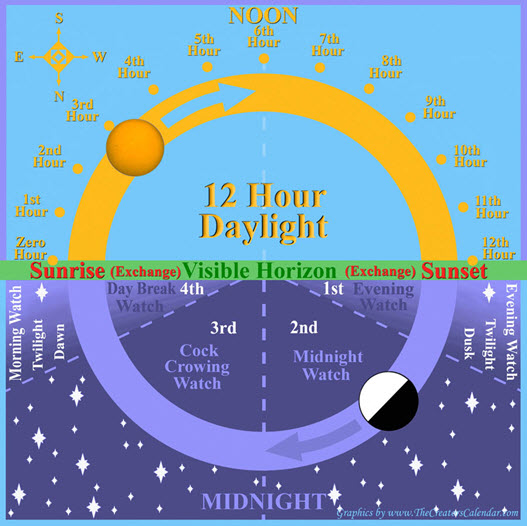 As a “nail in a sure place,” this verse in MatithYahu 28:1 has provided two witnesses defining that our Messiah, Yahusha, rose from the tomb “toward the end of the first of the week,” also called “dawn,” the fourth watch of the night of the 16th.
As a “nail in a sure place,” this verse in MatithYahu 28:1 has provided two witnesses defining that our Messiah, Yahusha, rose from the tomb “toward the end of the first of the week,” also called “dawn,” the fourth watch of the night of the 16th.
While it is the Greek word “proi” that is used in each of the other Gospels to describe this same event, the word “epiphosko” is used in MatithYahu 28:1. But, below it is seen that, indeed the two terms are synonymous.
The Greek word (epiphosko #2020) is defined as— to begin to grow light; dawn.

Matthew chose a different phraseology to describe the same resurrection event and did not utilize the Greek word “proi.” His description fully supports what has been found in John 20:1 and Mark 16:2, 9, which are coming up in this article for convenient comparison. This will provide a more complete perspective of this paramount event, just as a GPS would have greater precision in pinpointing an address by operating from three satellites rather than just two.
Make particular notice of the lunar phases in the graphic above, as was testified and recorded in Scripture. It was the dark moon that occurred on the 14th of Aviv, highlighting the fact that the true new moon has always been the full moon. For more on the lunar phase at the crucifixion, refer to The Sun was Darkened from the Sixth to the Ninth Hour.
Part 2
The Resurrection Occurred During
the Fourth Watch of the Night on the 16th of Aviv
Mark 16:1-2 and 9
In this interlinear word study for Mark 16:1-2 and 9, it is demonstrated that the women arrived at the tomb during the fourth watch of the night, on the first of the week, the 16th of Aviv. As a second witness in this text, Yahusha the Messiah also rose from the tomb on the first of the week during the same period of time.
If our Messiah had risen on the night of the 15th, He could not have been the fulfillment of the Feast of First Fruits (Wave Sheaf Offering) prophecy. To be the true Messiah, He had to rise during the civil calendar date of the 16th, as counted from the full New Moon. As mentioned in Part 1, “daylight” precedes “night.” So, when this or any text references “early in the morning,” “dawn,” or “while it was yet dim,” it is specifically referring to the last portion of the night, known as the “Daybreak, Morning Watch, or Fourth Watch.”
 Resurrected During the 4th Watch of the Night
Resurrected During the 4th Watch of the Night
From the interlinear Greek text, the following points from Mark 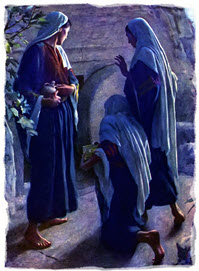 define weighty evidence that the Messiah and Savior, Yahusha, was raised from the dead during the fourth and last watch of the night and not at the commencement of the “day” at sunrise. The “fourth watch” referenced here is the first of the week, the 16th of Aviv, and not the 15th as traditionally held. The fact that “dawn” is synonymous with the fourth watch, the last portion of the night, applies gravity to the “day” and “full calendar date” commencing at sunrise rather than at sunset, as has been presumed.
define weighty evidence that the Messiah and Savior, Yahusha, was raised from the dead during the fourth and last watch of the night and not at the commencement of the “day” at sunrise. The “fourth watch” referenced here is the first of the week, the 16th of Aviv, and not the 15th as traditionally held. The fact that “dawn” is synonymous with the fourth watch, the last portion of the night, applies gravity to the “day” and “full calendar date” commencing at sunrise rather than at sunset, as has been presumed.
Significant Details
- The seventh-day Sabbath was past.
- After the Sabbath was past the women purchased spices for anointing and embalming the Messiah’s body.
- The women arrived at the tomb at dawn, (#4404 proi)—the period of night, which was known as the fourth watch or Daybreak Watch.
- It was the first of the week when the women arrived at the tomb, which was the 16th of the lunar month of Aviv.
- The second half of verse 2 gives a second witness that the women arrived at the tomb during the end of the night, and before the rising sun.
- The Messiah had already risen from the dead, when they arrived, therefore He had resurrected while it was yet night at the tail end of a full civil calendar date. Whenever (proi #4404) has been translated within the context of the resurrection, it was written as early in the morning or dawn, instead of (fourth watch of the night.) However, this very important word makes all the difference in rightly dividing the Creator’s units of time.
- Verse 9 reiterates that indeed, the Messiah rose
from the dead on the “first of the week,” during the “fourth watch of the night.” Therefore, this period was the dim period just prior to the sunrise of the 17th; giving us 24 full additional hours for the time period the Messiah was in the tomb. Refer to, article/word study, Sunrise or Sunset, When does a Day Begin?
Came to the Tomb in the Fourth Watch
The resurrection occurred during a specific portion of time on the “first of the week” and on the 16th calendar date of Aviv. But again, the nail in a sure place and the second witness. It is the word “early” that holds the key.
 Traditionally, the Greek word (proi #4404) has been translated as “early.” Might this have occurred sometime after Rome pressured the Israelites to accept their calendar with the Easter Sunday Resurrection requirement? As a result, it has caused all to believe this meant “early in the morning.”
Traditionally, the Greek word (proi #4404) has been translated as “early.” Might this have occurred sometime after Rome pressured the Israelites to accept their calendar with the Easter Sunday Resurrection requirement? As a result, it has caused all to believe this meant “early in the morning.”
Dark as It Was
As seen above, proi (#4404) is translated in the Strong’s Concordance as “dawn,” the “daybreak watch.” Thayer’s Greek Lexicon states, “1. Proi is the fourth watch of the night.” These are synonymous moments in time that occur prior to sunrise, during the fourth watch of the night. As a second witness that “proi” (#4404) is part of the night, causing “dawn” and the “fourth watch” to be synonymous with the night, is the fact that following the word “proi” in the text, it says, “dark as yet it was.” Therefore, proi, dawn, and the fourth watch are all of the night. In this case, the verse describes the night of the 16th, which followed the daylight hours of the 16th. As a result, the resurrection is postponed by nearly 24 hours from the popular Christian (Roman and Protestant) view.
The Night Watches
The Messiah himself refers to this watch as the “Morning Watch.”
“Watch therefore, for you do not know when the master of the house is coming–in the evening, at midnight, at the crowing of the rooster, or in the morning . . .” Mark 13:34 NKJV
“Daybreak Watch” and “Morning Watch” are the two names regularly used for the Fourth Watch or division of the night. As presented in other articles and Scripture, the fourth watch of the night is the end of a full 24-hour calendar date and not the beginning. See word study/commentary on Psalms 90:3-4, The Night is Cut Off as in Circumcision.
For a thousand years resemble days of yesterday when they are past, as the watches of the night. Psalms 90:4
Stated, when the night watches are passed, the night is over, and a new day has begun. Each new day, as well as a full civil calendar date, begins at sunrise. Daylight is always followed by the darkness of night, even in Genesis chapter 1.
Sunrise and Sunset
The traditional belief that the evening (night) is the beginning of a calendar date, followed by daylight, is based upon a proactive translation error designed by the Yahudim (Jews) to support their modern belief that the “day” commences at “night.” This new tradition was designed to prove that Yahusha is not the true Messiah. If the Yahudim (Jews) consistently make it look as though the SIGN of Yonah (Jonah) cannot be harmonized with the modern calendar, then they have succeeded in making Yahusha out to be a fraud. But strikingly, the opposite is true.
Suppose you are having difficulty believing the day begins at sunrise. Could it be that you are a Saturday Sabbatarian who has long been conditioned to believe the Jewish fable (Titus 1:14) that the “day,” which means “light” is synonymous with “night,” which means darkness? Yet, the principles that separate light and darkness are established in Genesis 1:1-5. Refer to the word study: A Day in Genesis.
Also not to be forgotten are the detailed principles set forth in Genesis 1:14. With distinction, the Creator divided the day from the night (light from darkness) using lights. But greater still is that which is revealed in verse 16. Here, we find the “day” is ruled and reckoned by direct and visible rays of the sun. The “night” is reckoned with the visible rising of the full moon together with the stars to rule along the east-west time continuum. As a result, the sacred seventh-day Sabbath, as beaconed by the light of the sun, is also from sunrise to sunset. Refer to the article, Visible Stars Define the Parameters of the Day.
Then Elohim/Alahim said, “Let there be lights in the firmament of the shamayim (heavens) to divide the day from the night; and let them be for signs and seasons, and for days and years . . . B’resheet Genesis 1:14-15
Then Elohim/Alahim made two great lights: the greater light to rule the day, and the lesser light to rule the night with the stars. B’resheet Genesis 1:16
The Strong’s Concordance clarifies that “proi” (#4404) is the night’s fourth watch. In other words, this Scripture verse specifies that Mary went to the tomb during the last watch of the night at the end of a 24-hour civil calendar date of the 16th and not at the commencement of, or “early” part of the day, as modern translations and tradition have held. The four watches were all considered part of the night and not part of the day. So we can deduce from this verse that dawn is equated with the fourth watch of the night, which is different than sunrise. This fourth watch ended at sunrise. Since the 24-hour civil calendar date was terminating with the fourth watch of the night, the next day would, therefore, commence at sunrise rather than sunset, the 17th of Aviv.
The Messiah’s Riddle Shows When a Day Begins
The final test demonstrating the truth about when a “day” really begins must meet the time-centric requirements of the Sign of Yonah and the Creation Week. The order given by our Messiah was emphatically stated as three days followed by their successive nights. If actual time were to be measured beginning with the night, then our Messiah erred Black Oversize blazer Balenciaga - Maison Mihara Yasuhiro logo-print sweatshirt - SchaferandweinerShops Japan in His description of the SIGN. It is that simple. But this cannot be true as He would not state something contrary to Creation or the objective of His SIGN. It was literal! Three days and three nights were given as a SIGN that met the criteria of both the Torah (law) and the principles of time during creation, as well as the Temple model. This SIGN was necessary to establish that Yahusha was indeed the true Messiah, in spite of the total renouncement by the Yahudim (Jews), the Atheists, or the changes made to time-measuring methods. The calendar of the world today bears no resemblance to that of Creation, the time of Abraham or Moses, and is here shown to not align with the time-centric facts surrounding the death and resurrection of our Messiah.
To continue believing and keeping time according to the “day” commencing at “night” (midnight or sunset) in light of the truth set forth in the original Greek is to side with those who declare the Messiah has not come or that He is an outright liar. It is impossible to account for three days and three nights when the day begins at night or dawn (the fourth watch of the night). On the other hand, arriving at three days that are each followed by three nights in the tomb, which terminate during the fourth watch of the night of the 16th lunar civil calendar date, receives the stamp of approval for unraveling the riddle of our Messiah’s declaration regarding the only sign He would give.
Our Messiah’s words were strategic
to the layout of His ETERNAL time-measuring model.
In the illustrated time divisions of the resurrection, overt evidence is brought to light that the division of “days,” as recorded in our modern translations in Genesis 1:5, has been either mistranslated, misunderstood, or both. It is the detailed timing of the events surrounding our Messiah’s crucifixion and resurrection that illustrate that the popular Christian view is not in harmony with a twenty-four-hour “day” that commences at sunrise. The weight of evidence shows the Creator’s “natural days” commence at sunrise and end at sunset, while His full civil calendar date is always measured from sunrise to sunrise instead of sunset to sunset.
Part 3
Women Arrived at the Tomb
On the First of the Week
Luke 23:55-56, 24:1, 13, 21
Beginning in Luke 23:55-56 some confusion arises as to when these events occur. So let’s look at both verses as a continuous and complete thought starting in verse 55. . .
“And the women also, which came with him from Galilee, followed after, and beheld the sepulchre, and how his body was laid. And they returned [home], and prepared spices and ointments [that evening]; and rested the Sabbath day [which followed the preparation day when the sun ruled the sky (Genesis 1:16)] according to the commandment.” Luke 23:55-56
So this sequence of events begins on the late afternoon of the 14th day of the lunar month, which is also the sixth day of the second week. It is illustrated here that the sacred hours of the Sabbath do not commence that evening for the very reason that the women, after viewing the tomb, went home and prepared spices. The Sabbath commenced at sunrise as it always had, even during the time manna was given in the wilderness. These women honored the sacred hours of the Sabbath according to the Torah Law.
Next is the interlinear word study in Luke 24:1, 13, which demonstrates the harmony of the four Brit Hadasha (NT) authors in reference to the time-centric evidence of the resurrection. While each shares different events, they help create a three-dimensional time-lapse whole. It is again illustrated that the resurrection occurred on the “first of the week, very early.” We have shown in each of the other examples that “very early” is synonymous with “dawn” and “fourth watch” of the night. Again stated, this refers to the period prior to the sunrise that is still the darkness of “night” and the end of the civil calendar day of the 16th.
The Morning of the Seventeenth
In Verse 1, Luke defines, in a repeat performance, that the women arrived at the tomb not only on the “first of the week at dawn” but as a second witness declares it to have been “very deeply early.” We discovered in the other gospel portrayals that “dawn” is the twilight period before sunrise. It is also synonymous with the fourth watch of the night. Thus rendering “dawn” the very last portion of the night. Adding this knowledge to the fact that the day” as well as a “civil calendar date,” commences at sunrise, we conclude that the resurrection occurred on the 16th and not the night of the 15th.
In Verse 13, while utilizing the Greek text for accuracy, it is found that the word “after” (Greek – #1722 en) was omitted by the translators. It becomes apparent that Luke intended to show that the journey to Emmaus occurred on the morning of the 17th, after all, and not on the 16th. This is because it states, “after that civil day was departed,” referring to the resurrection occurrence on the 16th. Therefore, the entire record of the events following the resurrection of Yahusha, our Messiah, supports that the resurrection occurred during the fourth watch of the night of the 16th, at the end of the civil calendar date. This is a full 24 hours later than most of the world believes the resurrection occurred. But for the first time, we can solve the Messiah’s riddle of the “Sign of Yonah,” as there is now a full accounting of “three days and three nights.”
As we begin to read Verse 21, please remember that the required three days and three nights have only been completed just now. Proof that places these believers on the road to Emmaus on the 17th day of the month, which is the second day of the week, is that the risen Messiah is alive again and joins them on their journey. If He had risen on the 16th, three days and three nights would not have been completed. He then expounds on the prophet’s written Scriptural Torah records, which record the things pertaining to himself, the promised one. If this journey had taken place the day prior, the Messiah could not have joined them because three days and three nights had to be completed.
English translated from Greek (KJV)
“But we trusted that it had been He which should have redeemed Israel, and beside all this, today is the third day since these things were done.” Luke 24:21
The above translation leaves much room for speculation about what day it was. Compare the English from Greek above to the Hebrew below, as translated from the Septuagint (Hebrew to Greek) and then used to translate the Renewed Covenant (New Testament) back to Hebrew.
“But we trusted that it had been He who would redeem Aleph and Tav Yasharal (Israel). As of today, it has been three days since these things were done.” Luke 24:21 (Translated from Greek to Hebrew and then to English using esword.)
Note that this does not say, “This is the third day.” The Messiah Himself set the rules that He would be in the tomb for three days and three nights. So He would only be available to walk with the believers to Emmaus on the day following the three days and nights, the 17th day of the lunar month that began at sunrise. It is simply impossible for the Messiah to be raised and walking with the believers before the three days and three nights reached its completion. Any translation that says otherwise is false.
Part 4
Mary Arrives at the Tomb During
the Fourth Watch of the Night
Yohanan John 20:1
In the interlinear word study below, it is demonstrated that Mary reached the tomb at the end of the 16th of Aviv, as it was said to be “the first of the week,” rather than the end of the 15th of Aviv. This postpones the resurrection by 24 hours. As you recall, Passover/Crucifixion was the 14th of Aviv, the Sabbath in the 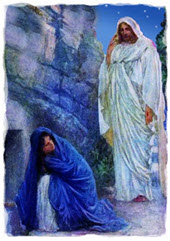 Tomb was the 15th, and resurrection took place on the 16th, the day of the First Fruits Offering or Wave Sheaf Offering.
Tomb was the 15th, and resurrection took place on the 16th, the day of the First Fruits Offering or Wave Sheaf Offering.
Since it has been discovered that the daylight precedes the night in a full calendar date, the fourth watch of the night would have been at the very end of the night of the 16th, which followed the day of the 16th, as it was called “dawn,” specifically meaning the Daybreak Watch of the night.
The importance of this point is two-fold: first, it meets the full criteria set forth by our Savior before His death, declaring that, indeed, He would be in the tomb “three days and three nights.” Second, it places Yahuah’s seal upon His appointed divisions of time: a “DAY” commences at precisely sunrise, not midnight, sunset, or dawn. A “day” is only 12 hours in length compared to a “full civil calendar date,” which includes both the daylight and the night.
 While It was Yet Dark
While It was Yet Dark
It is worthy of mention that commencing on “this first of the week,” the 16th lunar calendar day as counted from the full New Moon was the count to Feast of Weeks (Shabbuot/Pentecost),
Next, notice that this portion of Mary’s journey to the tomb is not only the first day of the week but also the very end of the twenty-four-hour civil calendar date of this sixteenth day. It goes on to clarify that when Mary reaches the tomb, “it is yet dark.” Therefore, the sun has not risen, and the new “day,” the 17th, has not yet begun.
Three criteria correctly define this calendar date, pinpointing it specifically to the first day of the week:
- Implicitly, the crucifixion occurred on Passover, the 14th of Aviv. Passover was the sixth day of the week, which was followed by the seventh-day Sabbath, the 15th of Aviv. Therefore, the following day could be nothing other than both the first day of the week and the 16th of Aviv, as counted from Passover or the New Moon.
- It is the day of the Feast of First Fruits or Wave Sheaf Offering, which was always to occur on the day after the Sabbath in accordance with Leviticus 23:11. Because the calendar dates and the days of the week are fixed and forever linked together, each and every year the Passover, Sabbath and Wave Sheaf Offering will always be the 6th, 7th and 1st days of their perspective weeks and simultaneously the 14th, 15th, and 16th dates of the lunar month. Strikingly, this principle forever fixes the week and Sabbaths, in addition to the civil calendar dates, to the count from the New Moon.
- It was already the 16th, the first of the week, but it was yet dark.
Since the day ended with the fourth watch of the night, the next day, on the 17th of Aviv, would commence at sunrise rather than sunset.
Only when both the “day” and “civil calendar date” commence at sunrise is it possible to solve the time-centric riddle given by Yahusha regarding the Sign of Yonah. Indeed, He was in the heart of the earth, three days that were each followed by three nights, no more and not less.
Part 5
Discrepancies Cited
Some discrepancies must be addressed.
Matthew’s Record of the Events that Immediately Followed Yahusha’s Resurrection — MatithYahu 28:10
Notice below in this NKJV translation that there is a discrepancy 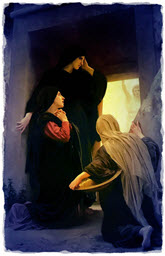 between what that angel said would happen and what actually happened with regard to the disciples meeting up with the risen Savior. While there is no conflict in Matthew’s record with the “new” discovery of the Messiah resurrecting at the end of the 16th civil day, when it was still dark, other events are not in harmony with the translations of Luke and John. In addition, there is conflict within this text with what the angel says to the women about where they will find the Messiah and when He meets them. See below.
between what that angel said would happen and what actually happened with regard to the disciples meeting up with the risen Savior. While there is no conflict in Matthew’s record with the “new” discovery of the Messiah resurrecting at the end of the 16th civil day, when it was still dark, other events are not in harmony with the translations of Luke and John. In addition, there is conflict within this text with what the angel says to the women about where they will find the Messiah and when He meets them. See below.
6 He is not here; for He is risen, as He said. Come, see the place where the Master [Yahusha] lay.7 And go quickly and tell His disciples that He is risen from the dead, and indeed He is going before you into Galilee; there you will see Him. Behold, I have told you.” 8 So they went out quickly from the tomb with fear and great joy, and ran to bring His disciples word.
9 And as they went to tell His disciples, behold, Yahusha met them, saying, “Rejoice!” So they came and held Him by the feet and worshiped Him. Then Yahusha said to them, “Do not be afraid. Go and tell My brethren to go to Galilee, and there they will see Me.” MatithYahu Matthew 28:6-10 NKJV
Mark’s Record of Events that Immediately Followed Yahusha’s Resurrection — Mark 16:7-14
This NKJV-translated record of Mark does not conflict with the “new” discovery of the resurrection occurring during the fourth watch of the 16th, while it was yet dark. Part of the reason it does not conflict is there are no time-centric details to place this account at specific times. This record is out of harmony with Matthew, Luke, and John, but for different reasons.
7 But go, tell His disciples–and Kefah (Peter)–that He is going before you into Galilee; there you will see Him, as He said to you.” 8 So they went out quickly and fled from the tomb, for they trembled and were amazed. And they said nothing to anyone, for they were afraid.
9 Now when He rose “early” [fourth watch of the night] on the first day of the week, He appeared first to Mary Magdalene, out of whom He had cast seven demons. 10 She went and told those who had been with Him, as they mourned and wept. 11 And when they heard that He was alive and had been seen by her, they did not believe.
12 After that, He appeared in another form to two of them as they walked and went into the country. 13 And they went and told it to the rest, but they did not believe them either. Later He appeared to the eleven as they sat at the table; and He rebuked their unbelief and hardness of heart, because they did not believe those who had seen Him after He had risen. Mark 16:7-14 NKJV
Luke’s Record of Events that Immediately Followed Yahusha’s Resurrection – Luke 24:12, 13, 18, 21, 24, 28, 32, 36
Peter at the Tomb on the 16th
The NKJV-translated record of Luke conflicts with the “new” discovery of the resurrection occurring during the fourth watch of the 16th. It is out of harmony with the translated record of Matthew and Mark. Here, we will take a closer look. First, read through the translated New King James version supplied below and then compare it with the word study table that shows the order of words that have changed and the important word that was completely omitted.
On the Road to Emmaus
The time-centric question is: Did the journey to the village of Emmaus occur on the 16th or 17th calendar date? Now, for a fresh new look, compare the following KJV translation of Luke 24:12, 13, 18, 21, 24, 28, 32, 36 with the word study table below it.
12 But Peter arose and ran to the tomb; and stooping down, he saw the linen cloths lying by themselves; and he departed, marveling to himself at what had happened.
13 Now behold, two of them were traveling that same day to a village called Emmaus, which was about seven miles from Jerusalem. 14 And they talked together of all these things which had happened. 15 So it was, while they conversed and reasoned, that Yahusha Himself drew near and went with them. 16 But their eyes were restrained, so that they did not know Him. 17 And He said to them, “What kind of conversation is this that you have with one another as you walk and are sad?”
18 Then the one whose name was Cleopas answered and said to Him, “Are You the only stranger in Jerusalem, and have you not known the things which happened there in these days?” 19 And He said to them, “What things?” So they said to Him, “The things concerning Yahusha of Nazareth, who was a Prophet mighty in deed and word before Alahim and all the people, 20 and how the chief priests and our rulers delivered Him to be condemned to death, and crucified Him.
21 But we were hoping that it was He who was going to redeem Israel. Indeed, besides all this, today is the third day since these things happened. 22 Yes, and certain women of our company, who arrived at the tomb early, astonished us. 23 When they did not find His body, they came saying that they had also seen a vision of angels who said He was alive.
24 And certain of those who were with us went to the tomb and found it just as the women had said; but Him they did not see.” 25 Then He said to them, “O foolish ones, and slow of heart to believe in all that the prophets have spoken! 26 Ought not the
Christ[Messiah] to have suffered these things and to enter into His glory?” 27 And beginning at Moses and all the Prophets, He expounded to them in all the Scriptures the things concerning Himself.28 Then they drew near to the village where they were going, and He indicated that He would have gone farther. 29 But they constrained Him, saying, “Abide with us, for it is toward evening, and the day is far spent.” And He went in to stay with them. 30 Now it came to pass, as He sat at the table with them, that He took bread, blessed and broke it, and gave it to them.
31 Then their eyes were opened and they knew Him; and He vanished from their sight. 32 And they said to one another, “Did not our hearts burn within us while He talked with us on the road, and while He opened the Scriptures to us?”
33 So they rose up that very hour and returned to Jerusalem, and found the eleven and those who were with them gathered together, 34 saying, “
The Lord[Yahusha] is risen indeed, and has appeared to Simon!” 35 And they told about the things that had happened on the road, and how He was known to them in the breaking of bread.36 Now as they said these things, Yahusha Himself stood in the midst of them, and said to them, “Peace to you.” 37 But they were terrified and frightened, and supposed they had seen a spirit. 38 And He said to them, “Why are you troubled? And why do doubts arise in your hearts? Luke 24:12-36 KJV
 After that Civil Day was Departed
After that Civil Day was Departed
In verse 13, both the Greek words for “after” (#1722 en) and “was” (#1510) were omitted by the KJV translators. In addition, the KJV word “went” is not even given as an option in either the Strong’s or Thayer’s Greek Lexicon, 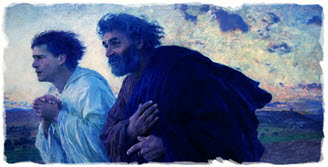 whereas the term “departed” is given as an option in both and makes a better word choice in harmony with the context: “after that civil day was departed,” [all civil calendar days begin and end at sunrise] after Peter had run to the empty tomb, the other disciples set off on the road to Emmaus. By restoring the words “after” and “was,” there is a change in the meaning of the verse. These restored words help clarify that the journey to Emmaus occurred after sunrise on the morning of the 17th, while the Resurrection occurred in the last dark hours of the 16th. Remember, too, that the night always follows the day in the day/night cycle of Biblical time-measuring.
whereas the term “departed” is given as an option in both and makes a better word choice in harmony with the context: “after that civil day was departed,” [all civil calendar days begin and end at sunrise] after Peter had run to the empty tomb, the other disciples set off on the road to Emmaus. By restoring the words “after” and “was,” there is a change in the meaning of the verse. These restored words help clarify that the journey to Emmaus occurred after sunrise on the morning of the 17th, while the Resurrection occurred in the last dark hours of the 16th. Remember, too, that the night always follows the day in the day/night cycle of Biblical time-measuring.
Therefore, the entire record of the events following the resurrection of Yahusha, our Savior, supports that the resurrection occurred during the fourth watch of the night of the 16th, at the end of the civil calendar date, while it was yet dark. This is a full 24 hours later than most of the world believes the resurrection occurred.
If the walk to Emmaus had occurred on the 16th, could the disciples and Paul later have stated that three days had departed since the crucifixion? Now we have a full accounting of “three literal days and three literal nights.” Take a moment to review the graphic illustration of the “Sign of Yonah.”
Part 6
John’s Record of Events that
Immediately Followed Yahusha’s Resurrection
Yohanan John 20:19-20
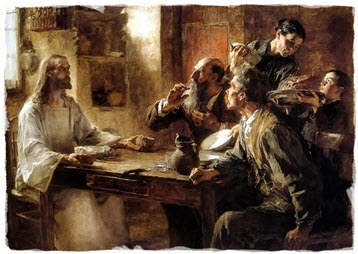
The NKJV translated record of John is in conflict with the “new” discovery of the resurrection occurring during the fourth watch of the 16th. It is also out of harmony with the resurrection events, as declared by both Matthew and Mark.
19 Then, the same day at evening, being the first day of the week, when the doors were shut where the disciples were assembled, for fear of the Yahudim (Jews), Yahusha came and stood in the midst, and said to them, “Peace be with you.”
20 Now when He had said this, He showed them His hands and His side. Then the disciples were glad when they saw the master Yahusha. 21 So Yahusha said to them again, “Peace to you! As the Father has sent Me, I also send you.” John 20:19-21 NKJV
 Journey to Emmaus
Journey to Emmaus
Placing each Greek word in its proper order and identifying the correct meaning, it is found that according to John, Yahusha appeared to the disciples on the 17th at night, on the second day of the first week, and not on the 16th, making this a full 24 hours later. This is further confirmed by the word “yet,” referring to the doors that continued to be closed for fear of the Yahudim (Jews) even though the “three days and three nights” were passed. Also, the “first-week” reference appears to correspond to the first week in the count to Pentecost.
The reality is that the risen Messiah, Yahusha, revealed himself to his disciples in the upper room on the night of the 17th civil calendar date, which commenced with sunrise and ended the following sunrise.
Thus John 20:19 is brought into harmony with the Luke 24 account of the journey to Emmaus. So it was that “it happened at night that selfsame civil day [the 17th] of the first week.”
Weight of Evidence of Each Record
Matthew 28:1 Reveals
Mary arrived at the tomb as it began to grow light toward 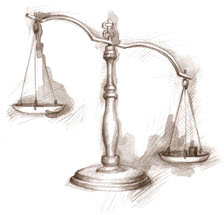 the end of the first of the week. Without using the word “proi” (fourth watch of the night), this verse verifies its truth using equal terms.
the end of the first of the week. Without using the word “proi” (fourth watch of the night), this verse verifies its truth using equal terms.
The first of the week was the civil calendar date of the 16th, as counted from the New Moon. A civil calendar date is an entire revolution of the earth. It both commences and terminates at sunrise. Therefore, it is at sunrise that the civil calendar date changes.
While there is a conflict between the events told in Matthew and the other gospels, there are no time identifiers that are out of harmony with the “new” discovery that the resurrection occurred during the fourth watch of the 16th, just prior to the sunrise of the 17th.
Mark 16:1-2 and 9
After the Sabbath was passed, the women purchased spices for anointing and embalming the Messiah’s body. This was during the darkness of night that followed the Sabbath daylight hours, the civil calendar date of the 15th.
- It was already the “first” of the week when the women arrived at the tomb, which was the 16th civil calendar date of the lunar month of Aviv.
- The women arrived at the tomb at “dawn,” #4404 proi—the period of “night,” which was known as the “fourth watch” or “Daybreak Watch.” This is a full 24 hours later than the traditional time pinpointed for the Resurrection.
- The second half of verse 2 gives a second witness that the women arrived at the tomb “during the end of the night, and before the rising sun.”
- The Messiah had already risen from the dead, perhaps a half hour prior to their arrival air jordan 6 toro, therefore He had resurrected while it was yet “night” at the tail end of a full civil calendar date. Whenever “proi” #4404, has been translated within the context of the resurrection, it was written by the translators as “early in the morning” or “dawn,” instead of “fourth watch of the night.” However, this very important word makes all the difference in rightly dividing the Creator’s units of time.
- Verse 9 reiterates that indeed, the Messiah rose from the dead on the “first of the week,” during the “fourth watch of the night [that followed the daylight, which was at the end of the night].” A lunar calendar date commences at sunrise and terminates the following sunrise, after the “fourth watch of the night.” Therefore, this period was the night to early twilight period just prior to the sunrise of the 17th, giving us 24 full additional hours for the time period the Messiah was in the tomb.
Luke 24:1 and 13
- On the first of the week, the 16th civil calendar date [sunrise to sunrise reckoning], the women came to the tomb with spices, at which time the resurrection had already occurred.
- It was very early “dawn,” which is identified as the fourth watch of the night of the 16th and not the 15th.
- The two men set out on the road to Emmaus after the 16th civil day was departed, meaning after sunrise on the day of the 17th. So later in Luke 24:24 they declared to the Messiah that three days had passed away since these things had begun.
John 20:1
- Mary arrived at the tomb on the first of the week, the 16th rather than the 15th during the fourth watch of the night.
- As a second witness it is clarified that “it was yet dark.”
- When she arrived the stone had already been removed.
John 20:19
It happened therefore, at night that selfsame civil day [the 17th] of the first week, when yet the doors were shut up where were the disciples by reason of their fear of the Yahudim (Jews). Then came Yahusha and stood in their midst, and said to them, “Peace to you.” John 20:19 [From the Restored Text of Word Study according to Strong’s Dictionary and Thayer’s Greek Lexicon.]
- At night, most likely an hour after sunset, on the 17th the Savior appeared to His disciples in the upper room.
- At had only been 14-16 hours since His Resurrection at the end of the previous night of the 16th.
- Most often this verse has been translated with the words “first day of the week.” Yet, both the words “day” and “the” were added by the translators causing this verse to say that the Savior appeared to His disciples on “the first day of the week” instead of “at night that selfsame civil day of the first week.” (Apparently the first week of the count to Shabuot/Feast of Weeks.)
- Understanding the Hebrew Festivals and in this case the Feast of Weeks, makes all the difference in discovering the correct wording and the impact it had on their living reality. Without adding any words, this verse declares that this event occurred on the same day Mary ran to the disciples to tell them that she had seen Yahusha, as no doubt she spent some time talking with them during which the sun had risen to commence the date of the 17th (John 24:18).
Order of Events During the Three Days and Three Nights
By rightly dividing the Word of Truth and commencing the days from sunrise to sunset and the civil dates from sunrise to sunrise, the following points are harmonized, and each occurs in their order from the morning of the 14th through the night of the 16th. Utilizing inclusive time reckoning, the Messiah’s riddle that He would be in the tomb for three days and three nights is solved.
- Yahusha was taken before Pilate at sunrise on the 14th of Aviv.
- Pilate give Yahudim (Jews) option of which prisoner to set free.
- Yahusha is placed upon the cross/stake before noon.
- The Sun is darkened from the sixth to the ninth hour. (This is a three hour solar eclipse, illustrating the moon was in its dark conjunction phase.)
- Yahusha said, “it is Finished” and died at the 9th hour (three o’clock).
- Joseph of Arimathea lays Yahusha’s body in the tomb between the 9th and the end of the 12th hour. (This is a four hour period that terminates at sunset.)
- All the Yahudim (Jews) enter their homes at sunset the night of the 14th (the end of the 12th hour) and follow the Torah law not to step outside their homes until sunrise. Note how the night of the 14th follows the day of the 14th.
- The Seventh-day Sabbath commences at sunrise on the 15th of Aviv.
- The first day of the Feast of Unleavened Bread begins at sunrise on the 15th making this a high Sabbath every year.
- No work is to be done during this 12 hour Sacred Sabbath. (John 11:9)
- Mary and other women went out to purchase spices for embalming after the Sabbath was past.
- The First day of the new week begins at sunrise on the 16th.
- The 16th is the second day of the Feast of Unleavened Bread and the Waving of the First Fruits Offering. (It may have been a sacred day.)
- There is a gap of nearly 36 hours between the time the women went to purchase spices and when they actually came to the tomb.
- YAHUSHA OUR MESSIAH RESURRECTED FROM THE DEAD, called forth by His Eternal Father (Mark 16:1-2, 9.), during the fourth watch of the night of the 16th, one to two hours before sunrise of the 17th of Aviv.
- Mary and other women arrive at the tomb and find it empty, while it was yet dark on the 16th (John 20:1).
- Mary speaks to the Yahusha, thinking Him to be the gardener, while it was yet dark on the 16th. (Mark 16:9) Yahusha tells Mary not to touch him at that point for He had not yet ascended to His Father to present Himself as the “first fruits of the grave.” This had to be completed to fulfill the prophetic Feast of First Fruits prior to sunrise, as that would mark the end of the civil day of this Feast.
- Our Messiah appeared and spoke to Mary, who ran to tell the disciples that He was risen.
- Peter, runs to the tomb and finds it empty with linens folded. (Luke 24:12)
- The risen Messiah is not seen again (as recorded) until the morning of the 17th, when He walked with some disciples and believers on the road to Emmaus.
- The walk to Emmaus had to occur the next day, on the 17th, as the two men on the road said to Yahusha, “three civil days have “passed away” since these things began.”
- Is it possible that once He ascended to His Father, he may have remained in His Father’s tender loving presence for a time as the entire host of divine messengers would have honored Him with rapturous songs of praise and adoration to their King.
- Later that night Yahusha appeared to His disciples in the upper room on the night of the 17th. (Yohanan John 20:19)
Time-Centric Facts Reveal Our Creator’s Calendar
The time-centric facts regarding the Creator’s Calendar come to light as the above evidence in Scripture underscores them:
- At the time-centric events surrounding the Crucifixion and Resurrection of our Messiah, the the natural day commenced at sunrise and terminated at sunset. Refer to, Sunrise or Sunset, When does the Day Begin?
- The night followed the natural day, which commenced at sunset and terminated at sunrise.
- The night was divided by four night watches.
- This same time system was consistently kept by our Creator, Adam, Noah, Abraham, Moses, and punctuated by our Messiah in His death and resurrection at the appointed time.
- It is this time system that will be restored by the Messiah’s followers at the end of time.
- The day beginning at sunset is a Jewish fable and commandment of men (Titus 1:14), which does not allow for three days and three nights by any other method.
- The notion that the Messiah’s resurrection occurred on Sunday, the morning of the first day of the week of the Roman calendar is an invention of Rome. We have all been led to believe Scripture calendar is in harmony with our modern calendar. But this is simply not true and is another fable, but of the Roman kind. Proof that they are not the same is that the Messiah’s riddle cannot be solved utilizing either the modern Roman or Jewish calendar models. Refer to article, Stunning Historical Evidence.
- The use of the words Friday, Saturday, and Sunday do not appear in either the ancient Hebrew or the Greek text. Some translations have added these Roman planetary designations to cause it to appear that the days and weeks identified in this pivotal story of Scripture are one and the same as the modern Roman calendar. However, this is an illusion to keep both the Jewish and Roman artificial time paradigms alive and well (Titus 1:14). Refer to article, Stunning Historical Evidence.
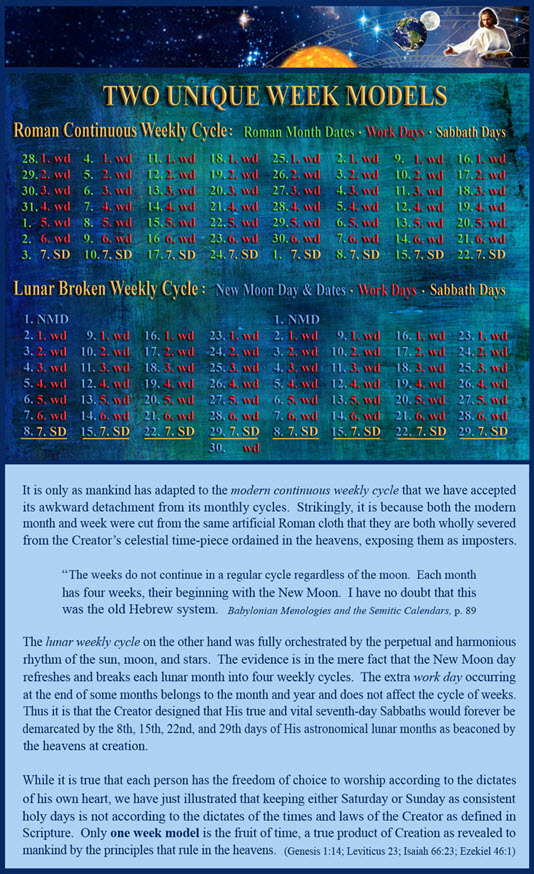
All four gospel accounts have been harmonized with the storyline and fully depict an accounting of the “three days and three nights” of our Savior’s prophesied riddle while “in the heart of the earth.”
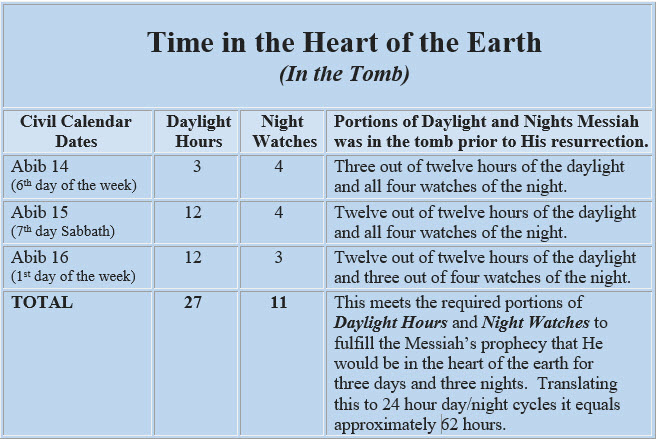 So roughly 62 hours are accounted for when our Messiah was deceased “in the heart of the earth.” Compare this figure to the Christians’ Catholic and Protestant accounting, which totals a mere 40 hours.
So roughly 62 hours are accounted for when our Messiah was deceased “in the heart of the earth.” Compare this figure to the Christians’ Catholic and Protestant accounting, which totals a mere 40 hours.
The Ministry of our Messiah Continues for You and Me
The Cross/Stake of our Messiah was the first step, and not the last, in the prophetic system to be performed in the Temple above, not made with human hands, on behalf of mankind. He provided the only way to restore humble, confessing sinners to the Eternal Father. He alone is the LAMB and the Zadok High Kohen (Priest) standing as our mediator before the justice and compassion seat of the Eternal Father’s throne. He will only return as the Victorious King for His Redeemed and likewise Victorious People.
This true and living Temple is built upon better promises (Hebrews 8:6) and founded upon the eternal principles of His astro-luni-solar time model. His Temple, not made with human hands, focuses on eradicating sin from humanity. It will continue until our Messiah’s Second Coming, at which time it will be forever finished and completed. However, the Creator’s preordained astro-luni-solar time system and Feast Day celebrations will continue into infinity and beyond.
Thus, the very signature of our Creator—astro-luni-solar TIME is the actual self-same model whereby His Passover lunar Sabbath seal is placed upon all his faithful universally.
If you seek a home with Him and an abundant life for all eternity, consider that His celestial timepiece in the shamayim (heavens) is the foundation for true worship and the SIGN OF THE TRUE MESSIAH.
For additional witnesses as to when the day begins, refer to:

